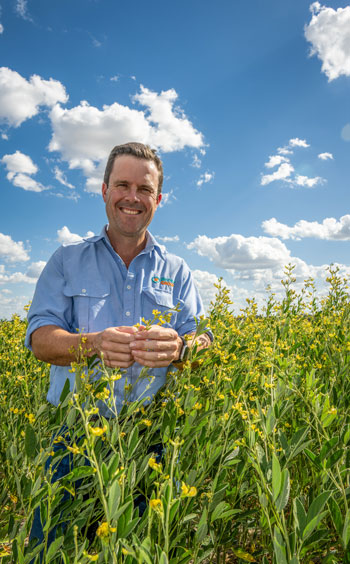Key points
- Agronomic trials for pigeon pea are building data so northern growers can be confident in deciding to try a new summer pulse option
- Woods Group is hosting trials on one of its farms near Goondiwindi, in western Queensland
- Pigeon pea is well-suited to the drier and hotter areas of Queensland and northern NSW, where mungbean and sorghum production are not as viable
- A strong market opportunity exists for pigeon pea, particularly when processed both in Australia and overseas
The beautiful yellow flowers swaying gently on a farm near Goondiwindi in western Queensland represent a new opportunity for Queensland and northern New South Wales growers.
The Woods Group is trialling pigeon pea as a broadacre summer pulse option in a joint project with GRDC, the University of Queensland and the Queensland Department of Agriculture and Fisheries (DAF).
The aim is to move the pulse from its position as a trap or refuge crop for cotton to a key summer legume for the drier and hotter areas of Queensland and northern NSW, where mungbean and sorghum production are not as viable.
With strong export market potential identified, the next step is building agronomic knowledge.
Woods Group director Angus Woods has been working with University of Queensland researchers on varietal development and breeding. On-farm, four different varieties are being trialled.
“Three of the varieties have been bred with Dr RCN Rachaputi at the University of Queensland and one is a line from ICRISAT (the International Crops Research Institute for the Semi-Arid Tropics).”
The selected lines are faster to mature than other commercially available lines at 95 to 110 days, with concentrated flowering and the potential to yield more than 2.5 tonnes per hectare in favourable conditions.
“It means we can get them planted and aim to harvest with a bit more certainty in regards to timing. And they are also more resilient than mungbeans,” Mr Woods says.

These yellow and pink flowers represent a new opportunity for Queensland and northern New South Wales growers – pigeon pea. Photo: Nicole Baxter
The agronomy trials are testing yield, time of sowing, row configuration, plant population, starting available moisture, water use efficiency, fertiliser use, and what nitrogen is provided by the crop.
By early March, when GroundCover™ visited, the trials that were planted in mid-December had received 290 millimetres of rain. The second set of trials planted on 24 January had received 162mm of rain by the same time.
Mr Woods says that ideally, the crops would have been planted in October, “but we didn’t have the rain”.
 Agronomic trials for pigeon pea are building data so northern growers can be confident in deciding to try a new summer pulse option. Photo: Nicole Baxter
Agronomic trials for pigeon pea are building data so northern growers can be confident in deciding to try a new summer pulse option. Photo: Nicole Baxter
Woods Group is also bulking up lines with the aim of commercially releasing one or two preferred varieties to growers by 2026. “We have 1ha blocks scattered throughout the farm to do this.”
Underlying all the agronomic data will be yield data, he says. “It will give growers confidence to try a summer pulse crop on a block that perhaps hasn’t done well with summer crops before. All the data we are creating will help that.”
GRDC grower relations manager – north Rebecca Raymond concurs. She says the trial will help identify best management practices, providing growers with confidence.
Mr Woods says there is a strong export market opportunity for pigeon pea, particularly when processed. “It can be made into toor dahl (split pigeon peas). By selling as a dahl, it means we remove the skin during processing, hence grain colour isn’t a major concern to us at this stage of our varietal development.“
Building agronomic resources is an essential first step in developing a local market, he says. “Pigeon pea presents an exciting opportunity for Australian farmers. It’s not just about diversifying crops, but also about tapping into new markets and leveraging the success we’ve seen with other pulses like chickpeas and mungbeans.
“We aim to ensure that as we build this industry, growers have the necessary support and information to succeed, especially considering the significant market potential in the Indian subcontinent, where pigeon pea is a staple,” he says.
These trials will be harvested by May and results should be available by June this year, with more trials planted at multiple locations over the 2024-25 summer period.

























































